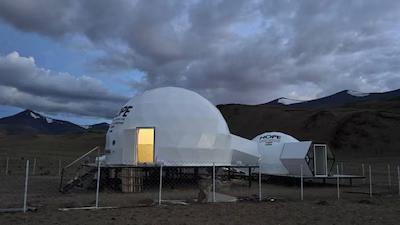
ISRO Sets Up Station in Ladakh to Simulate Life on Moon & Mars
In a significant step towards advancing the country’s space exploration capabilities, the Indian Space Research Organisation (ISRO) has set up the Himalayan Outpost for Planetary Exploration (HOPE) in Ladakh’s Tso Kar Valley. The high-altitude facility will simulate life on the moon and Mars, testing life-support systems for future lunar and Martian missions. The unique terrain of the Tso Kar Valley, with its high UV radiation, low atmospheric pressure, extreme cold, and saline permafrost, makes it an ideal location to mimic the harsh conditions on the Martian surface.
The HOPE station, also referred to as a “mini-Mars” or “mini-Moon” facility, will be operational for a period of 10 days, from August 1 to 10. Two crew members will undertake various tests at the facility during this time, simulating the challenges they may face on long-duration space missions. The crew will be subjected to a range of conditions, including extreme cold temperatures, reduced air pressure, and limited access to resources.
The primary objective of the HOPE station is to test and validate the life-support systems for future lunar and Martian missions. The systems being tested include life-sustaining equipment, communication networks, and propulsion systems. The data collected during the simulation mission will help ISRO scientists and engineers identify areas for improvement and optimize the design of future spacecraft and habitats.
The Tso Kar Valley was chosen as the location for the HOPE station due to its unique environment, which closely resembles the Martian surface. The valley’s high altitude, with an average elevation of 15,000 feet, provides a natural laboratory for scientists to test the performance of equipment and systems in low-pressure and low-oxygen conditions. The UV radiation in the valley is also significantly higher than on the Martian surface, which will help scientists understand how to protect equipment and crew members from the harsh radiation environment.
The HOPE station will also provide an opportunity for ISRO to test its emergency response protocols and contingency planning for situations that may arise during long-duration space missions. The crew members will be trained to respond to emergencies, such as system failures or medical emergencies, and will be equipped with specialized equipment and resources to support their survival.
The success of the HOPE station will pave the way for future Indian space missions to the moon and Mars. ISRO has already announced plans to send a manned mission to the moon in 2023, and the expertise gained during the HOPE simulation mission will be critical in preparing for this ambitious endeavor. The agency is also working towards establishing a permanent human settlement on the moon and Mars, and the HOPE station will play a crucial role in testing the technologies and systems required for these missions.
In conclusion, the HOPE station in Ladakh’s Tso Kar Valley is a significant step forward for India’s space program, demonstrating the country’s commitment to advancing space exploration and settlement. The simulation mission will provide valuable insights into the challenges of living and working on the moon and Mars, and will help ISRO scientists and engineers develop the technologies and systems required for future space missions.






